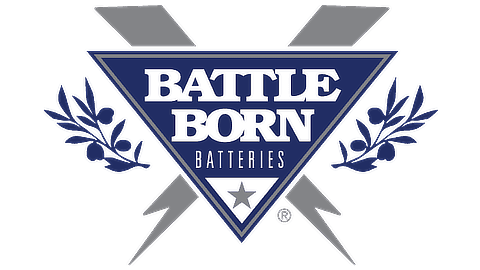“How much solar do I need for my RV?” That’s a question we’ve heard over and over again from RVers who are considering moving to solar. And we’re always glad to answer because we think RV solar power is fantastic.
We’ve spent lots of time running on solar power for many years, and we absolutely love it. We’re big boondockers, so we’re not tethered to a power pedestal very often. Upgrading our solar array and battery bank over time has been among the best investments we’ve made as RVers.
But there isn’t a blanket answer to give regarding the size of a solar array that’s needed for the average RVer. That’s because there really isn’t an average RVer. We’re all different, and we travel in different locations. We have different-sized RVs and different types of batteries, and the amount of electricity we use on a daily basis varies widely.
In other words, an RV solar system should be customized to the user.
So, today let’s talk about how to determine what makes sense for your solar panel system.
How Many Solar Panels Do I Need for My RV?
As we just mentioned, RV solar systems should be customized to the user’s needs. There are several ways to calculate those needs, but you have to consider various factors based on your particular RVing style.
In determining how many solar panels will be ideal for your RVing lifestyle, you need to look at everything from your average daily energy usage to the type of batteries you have in your battery bank. You’ll also want to consider how many square feet of interior space you’ve got in your RV, where you tend to travel, and more.
Let’s take a quick look at some of the things you’ll want to consider when planning your RV’s solar power system.
How Big Is Your RV?
The size of your RV and the amount of space you’re looking to heat or to cool can have an impact on the amount of solar you need. Generally speaking, a larger RV will have more electrical usage than a smaller one. Appliances will be larger, and there will typically be more lighting, fans and other gear that uses more power.
One of the biggest factors is that a smaller RV will have less space on the roof for a solar panel installation than a larger RV will have.
What Type of RV Batteries Do You Have?
If you’ve got flooded lead-acid batteries, you can only use 50% of their capacity before affecting their performance and lifespan. Lithium batteries, however, are designed to allow you to drain them to 80-100% (depending on the brand) without harm.
You need to consider both the type and the number of batteries in your battery bank when calculating your solar needs. They need to be sized to complement each other. After all, what good is a 2,000 watt solar array without the corresponding space (the battery bank) to store all the solar energy being captured?
Where Do You Travel?
The solar power available in April in Tucson will be far higher than in November in Washington. Where you travel makes a difference due to both weather patterns and latitude. When you RV matters too because of short winter days vs long summer days.
There are online resources available to help give you an idea of how much peak sun your panels will be able to “see” during the day.
What Will Your Panel Angles Be?
Will your solar panels lie flat on your roof, or will you be able to tilt them?
We included SolaRVector power tilt systems in our solar installation. They definitely make a dramatic difference, especially in the winter when days are short and the sun stays low in the southern sky. You can read more about this in our post on how much difference solar panel tilting actually makes.
You can also take a look at our post, “Should I Tilt My RV Solar Panels?” Tilt kits like the SolaRVector Powered Solar Tilt Kit or Renogy tilt kits can make a big difference if that’s a route you’d like to take.
- Adjustable solar panel mounting brackets designed for off-grid solar systems.
- Quick assembly with stainless steel fasteners and precise hole placement.
Whether you intend to flat mount rigid panels, adhere flexible panels to your RV roof, use tilt mounts, or use portable panels that you ground-deploy will factor into how much power your panels will produce.
Where Do You Tend to Park Your RV When You’re Camping?
If you typically camp in the shade to keep your rig cooler in the dog days of summer, you’ll need to remember that your solar panels will also be parked in the shade (unless you’re using portable panels that you can place in the sun away from your rig).
If forested settings are your favorite places to camp, you’ll want to keep that in mind as you plan your solar array. (Of course, if you only ever camp in the forest, you might want to reconsider investing anything in solar.)

Here we are camping in the forest, looking for the sun! Fortunately, we’re good at conserving power when we’re boondocking in locations where solar power isn’t available. And we have an onboard generator as a backup.
Note that other items can also shade parts of your solar panels, such as AC shrouds, antennas, vent covers, etc. Keep these items in mind when you plan for the location of the panels on your roof.
How Much Solar Can You Afford?
While you’ll want to decide how much to spend on your RV solar system, this question isn’t only about money. You also need to consider how much weight you can afford to add to your rig. Being mindful of your GVWR (Gross Vehicle Weight Rating) and, if you’re towing, the towing & payload capacities of your tow vehicle are also important considerations.
Rigid solar panels will add more weight than flexible panels, but there are other things to consider when deciding what type of solar panels you want. For more on this topic, see our posts on flexible solar panels vs rigid and the benefits of bifacial solar panels for RVs.
What Is Your Daily Average Electricity Usage When You’re Camping?
This is the biggest question to answer, and it’s so comprehensive that we need to give it a section all its own. There are several ways to calculate your average daily energy usage while you’re camping. Let’s take a detailed look at how to figure out the amount of electricity you’re likely to need, on average, each day.
How to Calculate Your Average Daily Electricity Usage When Planning Your RV Solar System
The only way to know how much solar you need for your RV is to start by calculating how much power you use daily on average. There are a few different ways to estimate your power needs and how much solar it takes to meet them. And there’s one way that’s more accurate than the others.
Let’s look at all three so you can choose which way you’d like to calculate the solar requirements for your RV.
Power Usage Charts
One way to estimate your daily energy needs is with power usage charts. These give you an estimate of how much each device and appliance in your rig uses. You’ll take each number and multiply it by the number of hours you tend to use that device each day.
Once you’ve got a number for each device and appliance, you’ll add up all those numbers to get the total number of Amp-hours of power you’re likely to use daily. Remember that power usage charts provide average (vs actual) numbers. You can also look at each of your particular appliances and devices for more specific information.
Some pretty neat calculators are available online, like this RV electrical load calculator from Boundless, a solar installer. Their calculator allows you to choose an appliance/device and input the number of hours you generally use it when camping. It automatically calculates the number of Amp hours per day you’ll need to run that appliance or device.
Then it asks you where you generally camp. This is so that it can calculate gains and losses based on whether you spend most of your time camping in the southwest, where the sun exposure is high, or in northern Montana, where there’s less exposure. It even calculates DC losses due to the use of 120V AC appliances.
Ultimately, it will help you estimate the number of solar panels needed for your expected power usage.
Use a Solar Guideline Based on Battery Capacity
With this method, you’ll use the guideline of having, in watts of solar, 2-3 times the useable amp-hour capacity of your battery bank.
For example:
Let’s say you have 400Ah of total capacity of flooded lead acid batteries. Remember that you should only ever use 50% of the capacity of a lead-acid battery to preserve its health and lifespan. This means that with 400Ah total capacity, you have 200Ah of usable battery capacity. Using the guideline that you’d want 2-3 times the usable Ah capacity of your battery bank, you’d want between 400 and 600 watts of solar panels.
Note that this is one of the many reasons people choose to upgrade to Lithium batteries. Depending on the brand, you can use 80-100% of the rated capacity of a Lithium battery. In addition, they’re lighter, which frees up weight for more solar panels (and other stuff, too). Lithium batteries also have lower resistance to charging, so they’ll charge faster using solar.
As an example, a Battle Born LiFePO4 deep cycle battery weighs only 31 pounds and has a life expectancy of 3000-5000 cycles. They charge very quickly and can be drawn down significantly lower than any lead-acid battery on the market without harming it. This means you get more use from a Battle Born LiFePO4 battery on a daily basis and over time.
Monitor Your True Power Usage
The most accurate method of determining how much solar you need is actually to monitor/measure your RV’s power usage.
12V DC Power Usage
For 12V DC power usage, you can install a battery monitor. It should give you accurate readouts for the amount of power you use during a day or a camping trip. For more detailed information, see our post on RV battery monitors. For a look at some of the high-quality battery monitors on the market, see our post on the best RV battery monitors.
These are three of the best RV battery monitors available:
The Victron Smartshunt is a single component that broadcasts data to an app on your smartphone. There’s no monitor panel to install, so fewer wires to be run.
- Victron Energy SmartShunt displays battery State of Charge % and acts like a fuel gauge for your batteries
- Victron Energy Smartshunt is an easy to setup, all in one battery monitor. It records voltage, current, energy and time remaining, and much more....
If you’d rather have a monitor panel that can be viewed without having to rely on an app, the Victron BMV-712 Smart Battery Monitor provides both.
- Victron Energy BMV-712 Smart Battery Monitor (Grey) is a high precision smart battery monitor for systems with battery voltage ranging from 6.5 - 70...
- Victron Energy BMV-712 features an additional input which can be programmed to measure battery temperature (temperature sensor sold separately),...
The Xantrex LinkPro Battery Monitor is also one to consider.
- Link lite Battery monitor
- Displays time remaining
120V AC Power Usage
There are several ways to calculate your actual 120V AC power usage. You can disconnect from shore power and run your inverter to power your 120V AC needs, allowing power draw to be tracked as 12V DC usage through a battery monitor like those mentioned above.
Alternatively, you can use a kill-a-watt device to monitor the 120V AC power use of one appliance or device at a time.
Finally, you could use a Hughes Power Watchdog in line with your shore power cord. This allows you to monitor all 120V AC power usage.
However, you do need to be aware that if your inverter doesn’t supply power to all 120V AC appliances (for example, air conditioners or your water heater’s 120V AC heating element), you shouldn’t use those appliances/devices when you’re conducting monitoring/testing. That’s because you won’t be able to run them off your batteries when you’re dry camping anyway.
An advantage of the Hughes Power Watchdog is that it also provides surge protection. You can also buy one of the models with EPO (Emergency Power Off) protection against over- and under-voltage conditions. We would never plug our rig into shore power without one.
Both 30A and 50A models of the Hughes Power Watchdog are available. RVgeeks readers get a 10% discount buying factory-direct from Hughes. MobileMustHave has just announced they’re also carrying Hughes products, and you can get a 5% RVgeeks discount there. Prices vary, so check Amazon, too!
Make sure your RV is protected from low voltage, bad RV park wiring AND power surges when connecting to shore power with a Power Watchdog and/or Hughes Autoformer. We never hookup without ours (we...Show More
Make sure your RV is protected from low voltage, bad RV park wiring AND power surges when connecting to shore power with a Power Watchdog and/or Hughes Autoformer. We never hookup without ours (we have both), and know our RV's electrical system and all our electronics are being protected.
Watch our Hughes Autoformer video
Watch our Hughes Power Watchdog video
Save 10% on your entire purchase when ordering from Hughes!
Show LessThanks to the latest additions to our RV internet arsenal from MobileMustHave, we're able to stay connected more reliably... and more remotely... than we ever could before. We couldn't be happier...Show More
Thanks to the latest additions to our RV internet arsenal from MobileMustHave, we're able to stay connected more reliably... and more remotely... than we ever could before. We couldn't be happier with the equipment we now have!
Upgrade your RV internet connectivity with great products from Peplink, WeBoost, Parsec, Poynting, Mobile Mark, and more. And while you're there, look at other great products like Viair Compressors!
Watch our video about our RV internet connectivity solutions for 2021
Save 5% on your equipment order at MobileMustHave.com when you click the button on this deal or use discount code "RVGEEKS" at checkout!
Show Less- Replaceable Surge / Spike Module: Should a large spike happen, surge module is completely replacable instead of replacing the entire unit.
- Wirelessly Monitor voltage, amperage, and wattage on your smartphone in real time using our free mobile app! Oldest and most reliable phone app in the...
- Replaceable Surge / Spike Module: Should a large spike happen, surge module is completely replacable instead of replacing the entire unit.
- Wirelessly Monitor voltage, amperage, and wattage on your smartphone in real time using our free mobile app! Oldest and most reliable phone app in the...
Once you know your power usage (in amp-hours), multiply it by 2-3 to get the total watts of solar you need to install. Then divide that number by the wattage output of the panels you plan to install. For example, 400 Watts of solar ÷ 100 Watt panel output = 4 panels needed.
Remember that installing 400W of solar doesn’t mean you’ll get 400W of output. The angle of the sun, weather, the cleanliness of the panels, and any trees or other obstructions all affect performance. And, of course, the time of year is important, with short winter days providing far less opportunity for solar charging.
A Note on Oversizing
With all the concern about having enough solar power to meet your average daily energy usage, it’s important to remember that you don’t want to oversize your system too much. Having enough solar is great, but too much solar can be a waste.
If your solar panels completely replenish your battery bank by noon every day, the remainder of the day’s sunshine may not be used since there’s nowhere to store that energy.
Check out our entire series of posts in our “Solar & Batteries” category for lots more information on this popular topic.
Free RVing Tips, Tricks, Reviews, Giveaways & More
Subscribe to our daily newsletter! We’ve been full-time RVers for 20 years (!) and share everything we’ve learned about RVing in our daily blog posts. Join our online community to receive a wealth of great RVing knowledge delivered right to your inbox.
Whether this is your first time on the road or you’re a seasoned full-timer, you’ll love the wide range of RVing topics we cover. Don’t miss a single article or any of our famous RV gear Giveaways — Subscribe today!











